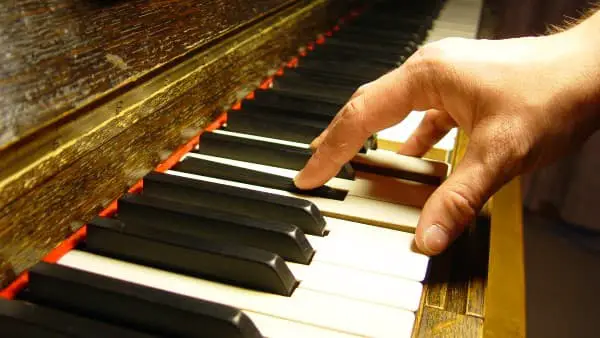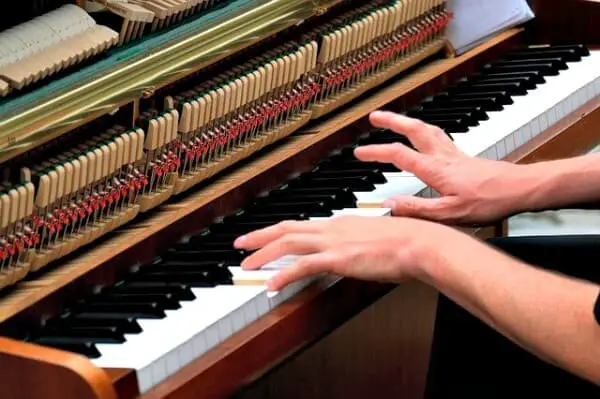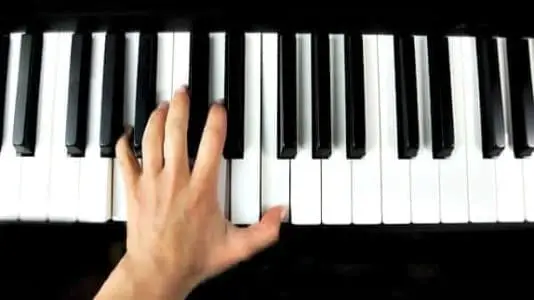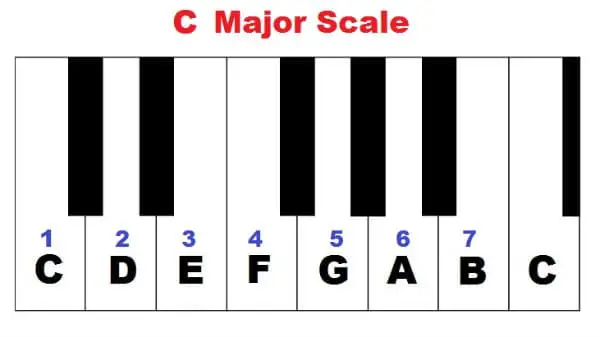- Home
- Piano Chords
Learn Piano Chords: Lessons for Beginners
This article may contain compensated links. Please read the disclosure for more info.
With the basic piano chords’ lessons below, you will learn how a chord is built, modified, inverted, and analyzed from scratch.
Among the piano lessons, there is also an introduction to the study of Harmony where you may experience some confidence-boosting results of what a humble little chord, or even better- a progression of chords, can do!
Why Learning Piano Chords?

For pianists, learning about chords is especially important. Since most piano compositions are created mainly with music chords and melodic patterns, knowing about chords will help you learn new music.
A good resource for all pianists is a book with the most common scale and chord patterns. I recommend keeping a copy of The Complete Book of Scales, Chords, and Arpeggios in your music library for reference.
You can also learn to play Chord Piano. Chord Piano is where you accompany a melody with different chord progressions. These are often written with chord symbols instead of notes.
If you're an adult beginner learning how to play piano on your own, you might want to check out Piano For All. It's a resource that offers self-paced lessons so you can learn piano on your own schedule.
With its user-friendly approach, the resource provides a fun and engaging way to learn the basics of piano, such as reading sheet music, playing chords, and understanding rhythm.
what is a chord?
 A chord in root position.
A chord in root position.What is a Chord? Let us start by clearing up what a chord is and what a good definition of musical chords could be.
The word Chord itself is derived from the ancient Greek word "khorde," which means "gut, or the string on a musical instrument."
(In Modern Greek, the word for Chord is "Synchordia," which means strings sounding simultaneous.)
Here is a short and simple definition of a chord :
A chord consists of three or more notes played together.
But the notes of a chord can be played in many ways and sometimes not together at all!
Chords can be played blocked (all the notes played simultaneously) and broken, or "arpeggiated" (the notes are played one after the other, like plucking a chord on a guitar).
harmony
Music chords are one of the main building blocks of music. Chords belong to a group of musical elements called Harmony.
So, what is Harmony in music?
Harmony happens (!) when music notes, in general, are played simultaneously. A chord is created when three or more notes are played simultaneously.
Harmony can be created by:
- Intervals (two notes played together).
- Chords (three or more notes played together)
- 2 or more melodies played/sung together. Or 1 melody starting at different times, like the well-known round “Row, row, row your boat.” (this is a simple form of Polyphony.)
Basically, any two musical notes that sound together creates harmony. The harmony can be either consonant (harmonious) or dissonant (not harmonious).
When studying music theory and harmony, you will learn that chords can sound peaceful or weird, ugly or pleasant, spicy or sweet. And we need them all!
The progression of chords creates tension and relief. Chords can sound as if they need to desperately go somewhere. And the following chord can either sound like “home” or keep the tension going.
You can use chords in a progression to lead the music forward or come to a stop. When learning about chords, you will see that they are potent ingredients in music indeed!
Music chords are so useful that, simply put, with your own little melody and some chords that fit, there is no limit to the kind of compositions you could make...
Read on and follow the links for more free piano resources for beginners!
Piano Chords Lessons for Beginners
different types of chords
There are 3 main types of piano chords:
- 3-note chords also called Triads,
- Extended Chords like 4-note chords, also called 7th chords,
- and Added Tone Chords.
Learn more in these lessons:
playing piano chords
Chord Piano
How do you play chord piano? Here are lessons on how to get started playing chord piano. It’s easier than you might think!
- Introduction to Chord Piano
- Learn Piano Chords -The Basics of Chord Piano Playing
- Easy Piano Chords for Beginners - Play Chord Piano with Amazing Grace
printable piano chord chart
Print the basic chords for an overview of the most common chords in root position. Fun! Here's a free printable PDF:
common piano chord progressions
Here are some fun ways to combine chords in different progressions.
chord inversions
Now the fun starts! Let's twist and turn those chords into new shapes!
Once you've learned how a chord is built in the root position, you can learn how any chord can be rearranged. This is called Chord Inversions.
Inversions simply use the same notes as the basic chord in root position but in a different order. Here is a lesson, with FREE printable PDFs:
analyzing chords
roman numeral chords
You can write chords in different ways, as notes, as chord symbols, or as Roman numerals.
diatonic harmony
Here we will look at the relationships between the chords. Yes! When chords are played together, they start sounding different than when they are played alone. A very fascinating subject indeed…
composing with chords
adding chords to a melody
Did you ever wonder how to make a song, and put chords to a melody?
Here is an easy piano chord lesson on how to add great-sounding harmonies to a little tune. Ah, did I mention it is easy? Have a look:
introduction to four part harmony
This is fun! Find or write a melody. Add some suitable
chords. Now write the concoction for four or more instruments….
You will begin to feel the power of being able to compose your own music!





